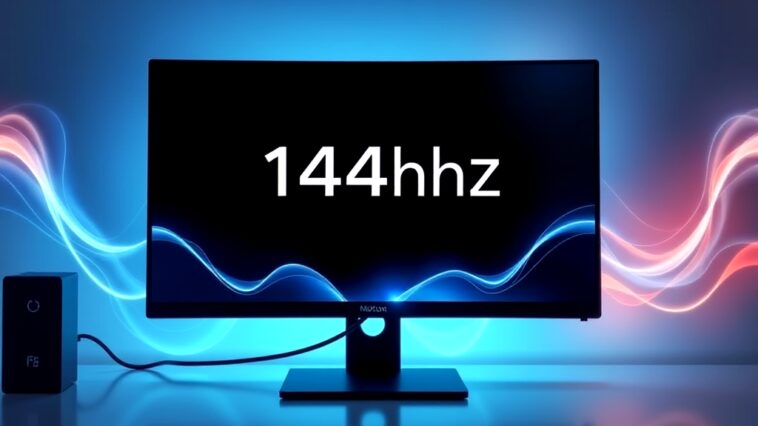So, you’ve finally decided to step up your gaming setup with a 144Hz monitor. Awesome choice! But have you ever stopped to think about how much power that beauty actually consumes? Spoiler alert: it might be more than you think. Let’s break down the nitty-gritty of 144Hz monitors and their power usage, along with tips on managing that energy draw.
1. What is a 144Hz Monitor?
First off, what exactly is a 144Hz monitor? Basically, it’s a display that refreshes its image 144 times per second, which is a big deal for gamers. This high refresh rate translates to smoother gameplay and a more responsive experience. But, all this smoothness comes at a cost—literally.
2. Average Wattage of a 144Hz Monitor in Operation
When it comes to power consumption, the average wattage of a 144Hz monitor typically ranges from 40 to 80 watts while in operation. That’s a broad range, right? But, it largely depends on various factors—like the monitor’s size, the technology it uses (LCD vs. LED), and its brightness settings.
144Hz Monitor Power Consumption for Gaming Setups
For gaming setups specifically, you might find yourself on the higher end of that scale, especially if you’re cranking up the brightness for those epic night-time gaming sessions. And don’t forget, if you’re running multiple monitors, that wattage stacks up quickly!
3. Energy Usage Comparison of 144Hz vs 60Hz Monitors
Now, you might be wondering how this stacks up against traditional 60Hz monitors. Generally speaking, 144Hz monitors consume more power than their 60Hz counterparts—sometimes up to 30% more. But here’s the kicker: the difference in gaming experience can be like night and day. If you’re a competitive gamer, it might just be worth the extra watts.
Factors Affecting Power Draw of a 144Hz Monitor
But what affects that power draw? Several factors can come into play:
- Screen Size: Larger screens generally consume more power.
- Panel Type: IPS panels tend to draw more energy compared to TN panels.
- Brightness Settings: Higher brightness means higher power consumption.
- Resolution: Higher resolutions can also increase power needs, especially if you’re gaming at 1440p or 4K.
4. How to Calculate Electricity Cost of a 144Hz Monitor
Alright, let’s get down to the math for a second. To calculate the electricity cost of running your 144Hz monitor, you’ll want to use this formula:
[ \text{Cost} = \left( \frac{\text{Wattage}}{1000} \right) \times \text{Hours of Use} \times \text{Cost per kWh} ]
For example, if you’re using a 70-watt monitor for 5 hours a day, and your electricity rate is $0.13 per kWh, it would look like this:
[ \text{Cost} = \left( \frac{70}{1000} \right) \times 5 \times 0.13 = $0.0455 \text{ per day} ]
Not too bad, right? At the end of the day, that’s about $1.37 per month if you use it daily. But, hey, if you’re a hardcore gamer, that might add up over time.
5. Power Requirements for 144Hz Monitors in Home Offices
You might think 144Hz monitors are just for gaming, but they can also be a fantastic option for home offices—especially for tasks that require quick refresh rates, like video editing or graphic design. However, consider the total power requirements if you plan to use them alongside other devices like a computer, printer, or other monitors.
6. Impact of Brightness Settings on 144Hz Monitor Power Usage
And here’s where it gets interesting: your brightness settings can significantly impact power consumption. A monitor set to maximum brightness can consume up to 30% more power than one running at 50% brightness. So, if you’re looking to save some energy, consider dialing it down a notch.
7. Are 144Hz Monitors Energy Efficient for Everyday Tasks?
You might be asking yourself, “Are 144Hz monitors energy-efficient for everyday tasks?” Well, the answer isn’t as straightforward as you might think. While they offer great performance for gaming, their higher power draw can be overkill for simple tasks like browsing the web or watching videos. In those cases, a standard 60Hz monitor might be more appropriate—unless you’re a die-hard fan of buttery-smooth visuals, of course.
8. Understanding the Power Supply Needs for a 144Hz Monitor
Now, let’s chat about the power supply requirements. Most 144Hz monitors will need a standard AC power outlet. The good news? They usually come with a power adapter that can handle the necessary voltage. Just make sure you’re using a quality power source to avoid any potential problems—because, let’s be real, nobody wants a fried monitor.
9. Is a 144Hz Monitor Worth the Power Consumption?
Honestly, I think this is one of the most debated questions in the gaming community. On one hand, yes, you get a smoother experience and potentially better performance in fast-paced games. On the other hand, there’s the added electricity cost and environmental impact to consider.
At the end of the day, if you play a lot of fast-action games, it might be worth it. But if you’re mostly using your monitor for mundane tasks, you might want to stick with something less power-hungry.
10. Tips for Reducing Energy Use with a 144Hz Monitor
If you’re sold on the 144Hz experience but want to keep your energy consumption in check, here are some handy tips:
- Adjust Brightness: Lower it to a comfortable level.
- Use Power-Saving Modes: Most monitors come with energy-saving settings—don’t overlook these!
- Turn it Off When Not in Use: This one’s a no-brainer, but you’d be surprised how many folks leave their monitors on.
- Consider a Timer: If you tend to forget to switch off, set a timer to remind you.
11. Power-Saving Modes Available in 144Hz Monitors
Speaking of power-saving modes, many modern 144Hz monitors come equipped with features like Eco Mode or Auto Power Off. These modes can significantly reduce power consumption when the monitor is idle or not in use. So, it’s kinda like having a built-in energy saver—who doesn’t love that?
12. Real-World Power Consumption of Popular 144Hz Monitor Models
Let’s look at some real-world examples. Some popular 144Hz monitors and their power consumption (in watts) when in use include:
- ASUS ROG Swift PG259QN: ~60W
- Acer Predator XB273: ~70W
- Dell S2419HGF: ~50W
These are just average figures, of course. Actual power draw can vary based on usage and settings.
13. How to Choose a 144Hz Monitor with Low Energy Consumption
If energy efficiency is a priority for you (and let’s be honest, it should be), consider looking for monitors that advertise low power consumption features. Check reviews for real-world usage and see if they mention energy efficiency. You might also want to look for models that meet Energy Star certification—this can be a good indicator of lower power needs.
14. Environmental Impact of Using a 144Hz Monitor Over Time
And now, let’s get a bit serious. The environmental impact of using a 144Hz monitor over time can add up. If you’re running a monitor that consumes more energy, you’re contributing to higher carbon emissions, especially if your electricity comes from fossil fuels.
So, it’s good to be conscious of your choices. The more energy-efficient your setup, the better for our planet—plus, you might even save a few bucks on your electricity bill too!
Conclusion: Weighing the Pros and Cons
So, how much power does a 144Hz monitor use? It varies based on many factors, but generally falls in the range of 40 to 80 watts. While they’re fantastic for gaming, their higher energy consumption compared to 60Hz monitors might not make them the ideal choice for everyone.
At the end of the day, it’s about balancing performance and power. Be smart about your settings, consider the tasks you do, and you might just find that your 144Hz monitor is a worthy investment—both for your gaming experience and your wallet.
And remember, whether you’re gaming or working, being mindful of your power consumption can lead to a more sustainable and cost-effective setup. Cool, right?




